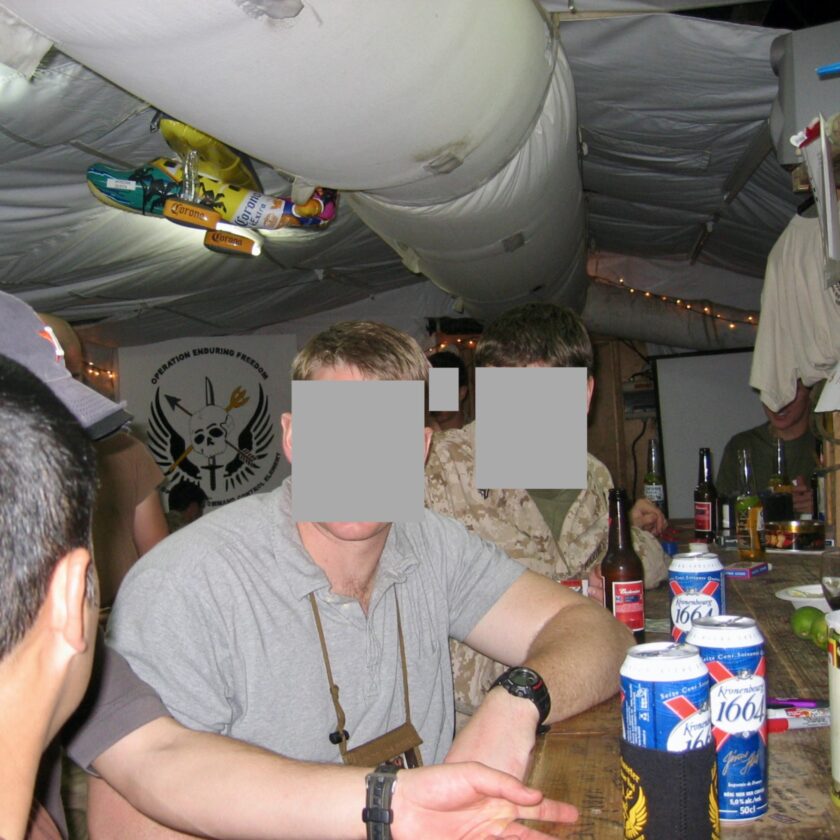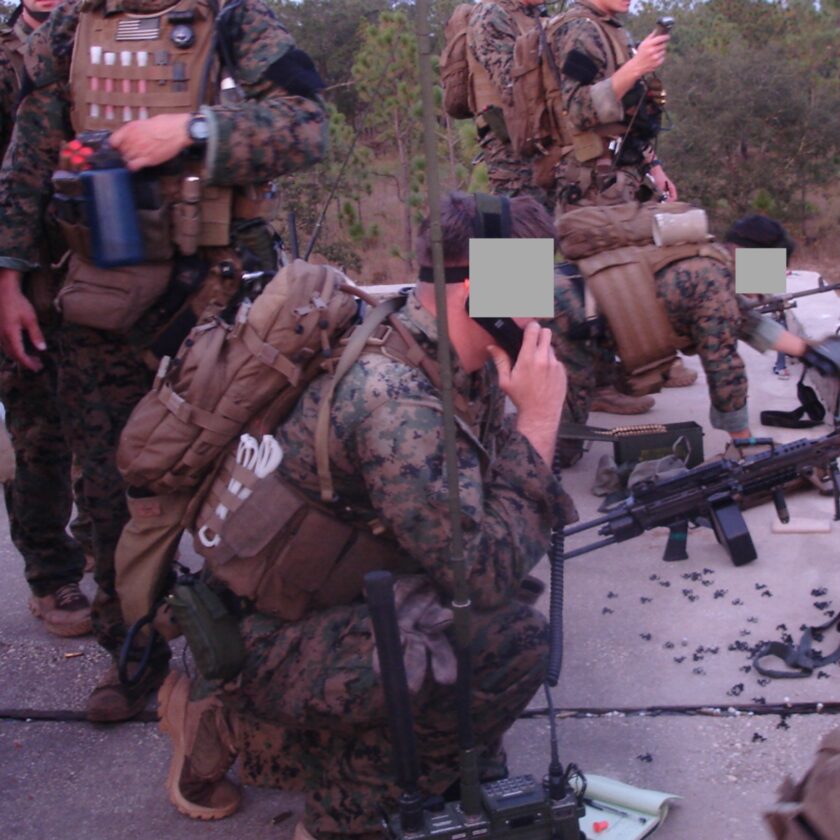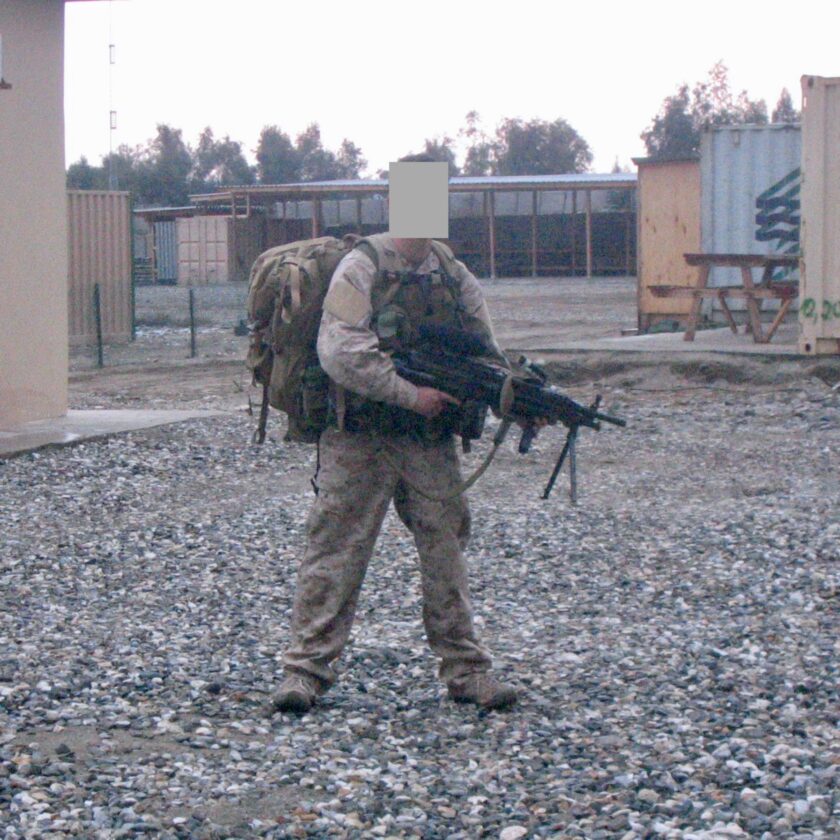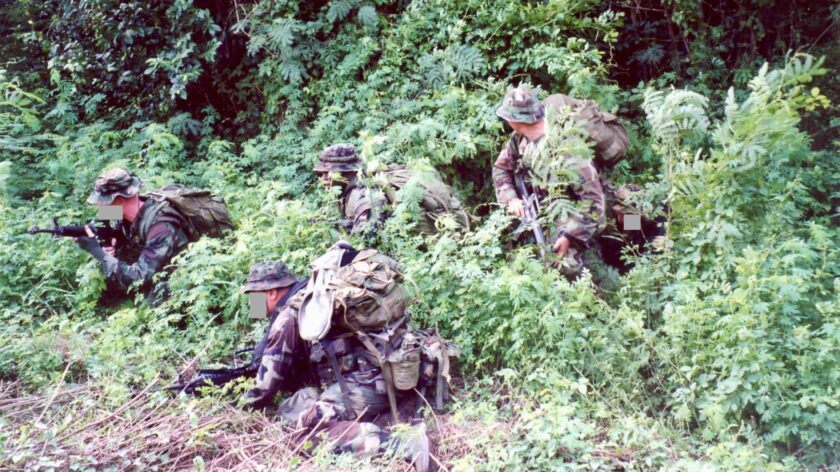The idea of “recce” is kind of becoming a trendy thing lately. Recce rifles and recce kit setups are showing up on YouTube and elsewhere, but what, really, is recce? That’s what I hope to get into over the next few weeks. This article will intro the series, and offer an in-depth discussion of the recce team.
The Recce Team | Recce Gear Loadout | Recce Rifles | Recce Team Insertion | Patrolling Skills | Individual Skills | Patrol Base Ops
This article contains affiliate links.
If you’re enjoying this series please consider supporting Swift | Silent | Deadly on Patreon. Each one of these recce articles represents somewhere between 8 and 20 hours of hard work. You support is greatly appreciated!
Recce Patrolling Series
I was chatting with a reader recently who asked that I write some “recce”-related articles, since no one is really writing about this stuff. The more we talked the more I realized he was right; it seems like everyone that has taken a two-day carbine class writes CQB-related articles. When’s the last time you read an article about patrolling, though?
This kicks off a series of articles covering recce patrolling. This article is a very loose intro to recce and a discussion of the format of the Marine Recon team. I already have several other articles in the works including articles on recce gear and weapons, patrol insertion, and the basics of patrolling. I imagine the gear article will be really popular, and the article on patrolling techniques will be pretty popular, too. so stay tuned
Caveats
First, this is based on my experience…or more accurately my memory of my experience (see my bio here). I have a decent amount of training and experience in a Force Recon team and Marine Special Operations team. Additionally, I spent five years teaching Special Reconnaissance at a U.S. Military special operations schoolhouse.
Unfortunately those experiences are a few years past, and my memory is fallible. I’ve also been out of the game for a few years and a few things have probably changed. There are also worlds of other recce stuff out there but I’m going to base this on my personal experience – not the art of the possible. Overall this should be a good starting point, though.
Second, although I love putting photos in my articles this series will be light on images. Unfortunately I don’t have a ton of on-the-job pictures from that time frame. These articles will be fairly text-heavy. Even if I did have a ton of pics I’m not sure how much good they would do in explaining much of this, other than making the posts more visually interesting.
Finally, reading is great, but it’s no substitute for training and practice. I put that last because it should be obvious. This series is only an intro to recce – to actually do it, you need to get out and do it. Some of you may have the idea that you will rise to the occasion when it is “for real.” I have some bad news for you: you will not. You will perform in “real life” the way you perform in training. If you have no training, you will perform poorly. Train and practice.
Recommended Reading
Wait – there’s one more caveat: I’m not giving up anything sensitive. Nothing here is really new, groundbreaking, or something you can’t find in a field manual somewhere. Most of “recce” is just basic soldiering, done really well. In fact, here is some recommended reading, directly from the Army and the Marine Corps:
- Ranger Handbook (Amazon link)
- Marine Rifle Squad, MCWP 3-11.2
- Ground Reconnaissance Operations, MCWP 2-25
- Reconnaissance Reports Guide, MCRP 2-10A.7
- Antenna Handbook, MCRP 3-40.3C
If all this stuff is available via field manuals, why am I writing about it? Frankly, field manuals are boring. They don’t provide examples and often lack nuance. I’m hoping to add just a little personality to it. Though not from the Army or Marines, I also recommend Special Reconnaissance and Advanced Small Unit Patrolling by Edward Wolcoff. I’m reading it now and though based in 1960s and 70s SOG stuff, it is still very valid.
What is Recce?
The word “recce” (pronounced “reck-ee”) is a synonym for “reconnaissance.” If memory services it is a British term and I first ran across it in about 2002 or 2003 while stationed out at 3rd Recon Battalion. Though not completely unknown this word was popularized at that time and place by a book called Bravo Two Zero, an account of an SAS’s soldier’s career centered on a crazy patrol gone wrong in Iraq. Some more colorful members of the 3rd Recon Battalion took to referring to the unit as “Third Recce Batt” which sounded vaguely more colonial and interesting. I didn’t because I was merely a pogue back then and that’s the sort of thing pogues got hazed for.
My explanation of the word “recce” only begs a further question, thought: what is reconnaissance? Reconnaissance patrols are conducted primarily to gather information about the enemy. They are generally not conducted to initiate contact via ambush, raid, etc – those are “movement to contact” patrols. A recce element should – above all – remain undetected. A failure to remain undetected is an active compromise, and very bad business for the recce team.
Terminology
I will use the terms “recce,” “recon,” and “reconnaissance” interchangeably throughout. If the word “Recon” is capitalized, I’m referring to Marine Reconnaissance units generally.
One more quick, cool set of terms: “greenside” and “blackside.” In the military parlance (at least when I was active) recce work was called greenside patrolling. Greenside operations differed from blackside operations, in that blackside ops were kinetic/direct action. It’s really cool to be writing a little bit about greenside operations.
The Recce Team
I know most of us imagine walking around in the woods, alone and unafraid, but military operations are conducted by teams. As people in the Marines LOVE to point out even the smallest tactical unit, the Scout/Sniper team has two people. Generally the recce team consists of 4 – 6 people. This ground has been covered by the likes of SOFREP before but I’m going to get just a bit deeper.
First, I’m going to present the perfect-world, military version of the recce team. I’m going to give their descriptions (mostly) in order of seniority on the team. This is the model upon which we’ll base our “civilian recce team” on throughout the rest of the series. After I discuss the military team I’ll talk about how your cobbled-together, civilian version might be structured.
Team Leader (TL)
The team leader is the non-negotiable member of the recce team. If this is a one-man patrol, guess what that one dude is? Yep, he’s the team leader. Ultimately the team leader is responsible for anything the team does or fails to do. There’s a leadership lesson in there but I’ll try to leave it alone (for now) in the interest of sticking to recce stuff.
The team leader should be the most experienced recce team member, not merely the most senior. This was a big deal in the Marine Recon units when I was coming up. It wasn’t uncommon to see a SSgt (E-6) as an Assistant Team Leader or Radio Operator, working for a Sgt (E-5) Team Leader. This would be absolute heresy elsewhere in the military (including the USMC) but the recon community loved it.

As a civilian it’s unlikely you’re going to have anyone with a lot of reconnaissance experience. Your TL should probably be the dude with some military experience. Ideally this would be combat arms experience because he’s going to have to plan the patrol and have a lot on his mind during it. It probably shouldn’t be his first time at the rodeo.
The Team Leader generally carries an M4 with 203 grenade launcher attached.
Assistant Team Leader (ATL)
Next up is the ATL. The ATL should be the second-most experienced person on the team. The ATL is generally the “people-person” of the recce team. By people-person I don’t mean he’s all warm and fuzzy; actually, he’s the exact opposite. By people-person I mean he’s in charge of the people: making sure everyone is where they need to be, when they need to be there, with that they’re supposed to have. The ATL is the dude conducting pre-patrol inspections and that sort of thing.
The ATL is also the “heavy” – he metes out punishment. If you screw up, you’re going to get an appointment with the ATL, at least in the military world. In the civilian context with four or five of your buddies don’t let this go to your head or you might get your ass kicked.
The Assistant Team Leader goes last in the order of march. He is responsible for rear security, accountability of personnel, and obscuring sign. At security halts the ATL is responsible for policing the site after and making sure nothing is left behind. If no one else has any experience with communications the ATL might also be the Assistant Radio Operator. Make no mistake – the ATL is one hard-working hombre. I was never an ATL (I was an all-time RTO) but I respected all of the ones I had.
The Assistant Team Leader generally carries an M4 with 203 grenade launcher attached. If your ATL happens to be a sniper, he may also carry a sniper rifle lashed to his ruck.
Radio-Telephone Operator (RTO)
RTO is some antique terminology. Pretty much anyone nowadays can operate a telephone. However, “RTO” would make no sense without explaining the “T” so there you go.
The RTO is responsible for carrying the team’s primary comm gear. In my early experience this was almost always an ancient PRC-104 or newer PRC-150 radio, both of which operated on the HF band. Not unlike HAM radio, using HF comms required a decent understanding of radio wave theory. We constructed elaborate field-expedient antennas using fish reels, cobra heads, speaker wire, etc., set up counterpoises, could talk at length about the layers of the ionosphere way beyond “sun up, freq up!”
I was really lucky for that experience. Once combat ops in Iraq got into full swing we, and everyone else, got all the SATCOM channels we could stand and HF went to backup status. Nowadays its doubtful anyone practices much with HF comm.

I mention it because if you and your buddies get really serious about this stuff, you won’t have SATCOM. Using HF techniques is going to be your communication methodology, if you use radios at all. Your HAM Technician license is a great start, but how many of you have a reasonably powerful, man-portable setup? Have you carried it for miles off trail and have built antennas in the field, at night, in the cold and rain? Something to think about.
Anyhow, the RTO is in charge of comm†. He’s also responsible for security and other common-to-all tasks. If it sounds like he’s got it easy, don’t worry…and see the previous paragraph.
The radio operator generally carries an M4.
Point Man (PT)
Next up is the Point Man. Obviously the point man is in charge of walking point, or being first in the order of march. He is responsible for security to the front, and for navigation. The Point Man really needs to be paying attention; getting lost could cost the mission and he is the most likely to make contact with the enemy. He has to navigate the team through or around terrain obstacles, and keep his head up for IEDs and other types of booby trap.
As such, the Point Man should usually have the lightest rucksack. That doesn’t mean he’s only carrying his sleeping bag and pillow, but he also shouldn’t be over-burdened with 15 spare radio batteries. He will be carrying some portion of team gear like binoculars, a spotting scope, camera, lenses, tripods, etc. He’ll also probably be carrying a Claymore and a drum of linked 5.56 ammo.
Ultimately the TL is responsible for navigation (anything the team does or fails to do, remember?) so the TL and PT will work closely together to get the recce team where it needs to go. Whether the RTO or Point Man is the third in command is debatable and decided by who has the most experience. As an all-time-RTO I never really cared; at the point that we’re looking at who the 3IC is we have bigger problems.
Forget about the Vietnam stuff about the Point Man carrying a shotgun; nowadays he carries an M4.
Assistant RTO (ARTO)
The ARTO, pretty obviously, helps out the RTO. This is a great position for a new member of the team. The ARTO will carry the secondary radio, batteries, his own field expedient antenna kit, etc. Ideally the RTO will be spending some time with him, showing him how to set up and use the comm gear. This gives the RTO some much needed help with building antennas, typing up reports and optimizing images for transmission, etc.
The ARTO provides redundancy in case something happens to the RTO. It also gives the team the ability to split into two elements (usually PT/TL/RTO and ATL/ARTO/SC) if, for some reason that is desirable. Both elements then have a functioning communication capability. In addition to helping the RTO, the ARTO is responsible for flank security and other common-to-all tasks.
The ARTO generally carries an M4.
Slack Man or Scout (SC)
If you actually have six dudes on the team your sixth guy is the Scout, affectionately known as the “Slack Man.” I believe this is an ancient Sanskrit term that loosely translates to “carries heavy shit.” The Scout is usually the most junior man on the team and gets burdened with all the extra optics, ammo, batteries, green gear, etc.

The Scout generally carries the fire-support weapon, i.e. the Mk46 or Mk48.
Order of March
I vacillated on how to present the members of the team: by seniority or order of march. Since I chose to present them roughly in order of seniority, order of march still needs to be covered. This is simply the textbook order of the men as they are in patrol formation. Here goes:
- Point Man
- Team Leader
- RTO
- ARTO or Scout
- Scout or ARTO
- ATL
The exact order of march is at the discretion of the team leader. Order of march can change based on things like terrain. If the point position is especially difficult (due to things like very heavy brush) the entire team may rotate through the point position.
Also, the ARTO and Scout are more or less interchangeable but the remainder of the positions remain relatively constant. I prefer that the ARTO and RTO walk together in the order of march. This way at long-security halts when the team needs to get comm with HQ, the ARTO can help the RTO are already together.
A counterpoint to that is a single burst of machine gun fire could take out both of your communicators. Comm is really important, so putting the two of them together in the order of march incurs slightly more risk.
Modifications to The Recce Team
A smaller team has advantages and disadvantages. The smaller the team is, the more stealthy and agile it is. A smaller team just leaves a small footprint, can insert in a smaller vehicle, and can work out of a smaller patrol base. There are LOTS of disadvantages to a smaller team, however.
The smaller the team, the the weaker it is. Each gun out of the fight is a serious reduction in firepower when, at best, you’re six strong. The fewer the men in the team, the less rest each person gets as security, observation, and other continuous duties must be divided among the group. The injury of one man can take two more out of the fight leaving only one effective shooter. I could go on and on, but you get the idea.
Smaller Teams
It’s not uncommon at all for a team to be below full strength. If the team is not a full strength it can still go to work with as few as four members. The Scout and ARTO can be cut from the roster, in that order. If the scout is out, his load will be divided up between everyone else, and the ARTO will probably end up carrying his fire support weapon.
If someone else has to go it’s the ARTO billet. Maybe you just don’t have an ARTO to begin with, or maybe the RTO is out – by injury, for instance. In that case the ARTO will step up to fill the RTO spot and the team will have to get by without an ARTO. Again, mission-essential gear will get split up. At this point the ATL will carry the fire support weapon…or your team will may run without one. That sucks, but sometimes things suck – it’s just the way life is.
Reinforced Teams
Your team also might be reinforced with a few extra dudes. Reinforcements might be guys providing some unique capability, or it could just be a couple goons should things get hairy. Extra capabilities might be a designated medic (have you noticed yet that the recce team doesn’t have a medic billet?). If the team does have a Corpsman or medic he’s responsible for one of the previously-listed billets, PLUS his medical duties).
You could have a couple Radio Recon guys providing SIGINT or EW (I hesitated on writing that, but it’s contained in completely open source material). Reinforcements could be fire support guys like a JTAC or TACP, though hopefully your TL or ATL has one of those quals. You may have an EOD guy, an interpreter, a mortar man…
Or again, you could just have a few extra goons. This is always a delicate balance of weighing the compromise risk of more dudes against the additional firepower of those same dudes. Generally recon units err on the side of lighter, faster, and more agile. The recce team is not a movement-to-contact force, it’s a recce team.
What Your Team Might Look Like
There are going to be some notable differences between a military team and whatever you can cobble together with your neighbors and buddies. Your capabilities are going to greatly influence your team organization. Since communication is the major limit in the civilian context (we’re assuming no cell service, or serious risk of compromise if you do use a phone) let’s address that first.
The Communication Limitation
Though you need RTO/ARTO positions, you are unlikely to have the training or gear to support them. A home base-station HAM radio is way different from a man-packable radio, and the HAM Technician license is a far cry from being a recce team RTO. If you want a commo capability I would recommend training first, then basing equipment purchases off what you learn in training. The only training I know of in this realm is offered by NCScout who has basic and advanced RTO courses.
Even if you have an awesome man-pack radio, you need someone listening back in “the rear.” This means another modestly trained person, as well as another radio. Let’s also not forget that civilian radios are prevented by law from employing encryption or cool thinks like frequency-hopping. That’s a pretty big limitation. Also remember that governments (let’s assume you’re assembling your team because the U.S. has been invaded) have insane direction-finding capabilities. This means keying the mic could be a hand-written invitation to an incoming 81mm-mortar round.
You can see pretty quickly how communications can be a tough nut to crack. While a military team reports on a regular schedule, a less comm-capable team could still perform recce. They could report their findings in-person, at the end of the patrol. That won’t work for time-sensitive stuff, but not everything is super time-sensitive. It also places the team at significant risk, since they can’t call for backup or extract if they do get in trouble.
The More Realistic Option
So at this point, in the absence of some serious investment in money and time, our notional team is without a serious comm capability. As I’ll cover in the next installment on gear loadouts, this comes with some benefit. It frees you up to be much more lighter and agile. It also frees up a little space in your ruck for a few creature comforts, but as we’ll see, the recce life ain’t a comfortable one.
With no RTO and ARTO in the mix, you team size is down to four guys. I think that is an outstanding basis for a very light, agile recce team. I would think seriously before adding to that number. That leaves you with a Point Man, TL, Scout, and ATL. You can trim this down by maybe one more dude…but remember, you still have work to do in the field. It’s not a camp out. The smaller the team gets, the more duties everyone carries and the less rest they get.
You can pretty much forget about a one-man recce. The “One Man National Asset” is a neat idea, but everyone has to sleep sometime. I would absolutely not want to got to sleep without someone on security. Even two men means, at most, you can get a 50/50 rest plan. Divided by two men, both of whom are physically exhausted, hungry, and cold… well, go outside and do it for a couple nights maintaining security at all times before you get any ideas about how easy it is.
Conclusion
That’s pretty much the recce team in a nutshell. Again, this might have been a bit tedious, but it is foundational information to everything we do going forward. Stay tuned – the next article in the series will cover recce gear loadouts.
I hope you’ve enjoyed this and if you have any feedback, please get at me!

Footnotes
†A note on terminology: comm, comms, commo. Here’s a quick pro-tip: you can usually tell what branch of service a dude is from by a couple key terms around communication. Marines are much more apt to refer to “comm” as in “the comm guy” or “comm gear.” Army dudes are way more likely to use “commo” as in, “get commo with higher” or “where’s the commo guy?” I worked in a lot of joint environments so sometimes you’ll hear me use both, and sometimes I’ll refer to “comms.” I have no clue where that one came from.
Oh, and one more. If you’re wondering if a dude is/was Marine or Army get him to say MBITR by casually working it into the conversation. The PRC-148 MBITR (Multi-Band, IntraTeam Radio) is an individually-worn radio. Marines call in an “em-biter” and army Joes call it an “em-bitter,” or at least they did a million years ago when I was in.





